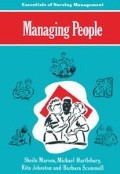Abstract
‘Why bother?’ ‘We all know why we’re here: this is a waste of time!’ This sort of comment may be made if you attempt to set aims and objectives for your team. Yet unless the team knows what it wants to achieve, it is unlikely to be fully effective. All teams exist for a purpose, but the way they work often suggests that this purpose is unclear.
Preview
Unable to display preview. Download preview PDF.
References
Woodcock, M. 1979. Team Development Manual. (Gower.)
Further reading
Carlisle, H.M. 1976. Management: Concepts and Situations — Instructors’ Manual. & (Science Research Associates.)
Syer, J. D. 1986. Team Spirit — The Elusive Experience. (Kingswood.)
Woodcock, M. and D. Francis 1982. The Unblocked Manager — A Practical Guide to Self-Development. (Gower.)
Copyright information
© 1990 Sheila Marson, Michael Hartlebury, Rita Johnston, & Barbara Scammell
About this chapter
Cite this chapter
Hartlebury, M. (1990). Team building: a practical approach. In: Managing People. Essentials of Nursing Management. Palgrave, London. https://doi.org/10.1007/978-1-349-10942-5_2
Download citation
DOI: https://doi.org/10.1007/978-1-349-10942-5_2
Publisher Name: Palgrave, London
Print ISBN: 978-0-333-49467-7
Online ISBN: 978-1-349-10942-5
eBook Packages: MedicineMedicine (R0)

